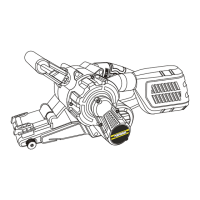WARNING: Know your belt sander. Read
the Owner’s Manual carefully. Learn the
tool’s applications and limitations, as well as
the specific potential hazards related to this
tool. Following this rule will reduce the risk of
electric shock, fire or serious injury.
Always wear eye protection. Any
power tool can throw foreign
objects into your eyes and cause
permanent eye damage.
ALWAYS wear safety goggles (not glasses) that
comply with ANSI safety standard Z87.1.
Everyday glasses have only impact resistant
lenses. They ARE NOT safety glasses.
WARNING: Wearing glasses or goggles
that do not comply with ANSI Z87.1 could
cause serious injury if they break.
Always wear hearing protection and a dust
mask. Use only in a well-ventilated area. Using
personal safety devices and working in a safe
environment reduces the risk of injury.
DANGER: Always unplug the tool from
the power source before changing the
sanding belt or cleaning the tool.
DANGER: Never place hands or fingers
near the sanding belt while the tool is
running. Severe injury will result.
WARNING: When turning the tool ON,
make sure the sanding belt is tracking in the
center of the rollers.
WARNING: After prolonged use, external
metal parts will become hot to the touch.
Always turn the switch OFF and wait for the
sanding belt to come to a complete stop before
putting the sander down.
Always make sure the work surface is free of
nails and other foreign objects. Contacting a nail
can cause the tool to jump. It will also damage
the sanding belt.
Always use a safe method to secure the
workpiece. Never place hands near the sanding
belt.
Never lay the workpiece on hard surfaces such
as concrete, stone, etc. The tool may jump if the
sanding belt contacts the hard surface. The
sanding belt will also be damaged.
Make sure all rags, cords, string etc. are
removed from the work area. Any of these items
could be caught in the sanding belt and cause
loss of control over the tool.
Never operate the tool while covering the air
vents with your hands. The motor will overheat.
Do not force the sander. Let the tool do the work
at a reasonable speed. Overloading will occur if
too much pressure is applied and the motor runs
slower, resulting in inefficient sanding and
possible damage to the motor.
When sanding wood, use the vacuum whenever
possible.
Never use the dust box or vacuum when
sanding metal. Sparks could ignite the dust
collected in the vacuum.
Do not continue to use a worn, torn or clogged
sanding belt. The sanded surface will be rough
and the motor will become overloaded.
SAVE THESE INSTRUCTIONS FOR REFERENCE

